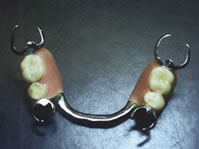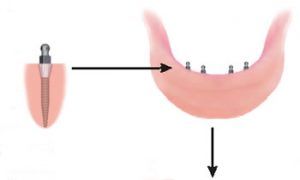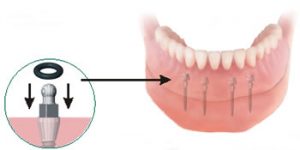
- Restore your self-esteem
- Regain your eating ability
- Aid speaking ability
- Give support back to the lips and cheeks
(giving you a natural and younger appearance).
A Complete Denture is placed in the patient’s mouth after all the teeth have been extracted and the gum tissue has healed. Healing takes anywhere from a few weeks to a few months, depending on the patient.
An Overdenture usually requires that at least 2 roots be kept. These roots may be used to hold the denture in place by placing inserts in the roots and in the denture. The denture then attaches to the roots. These roots also give support to the denture and help retain the ridge the denture sits on.
An Immediate Denture is placed the same day the teeth are extracted. The advantage of an Immediate Denture is that the patient does not have to be without teeth during the healing period.

An Implant-Retained Denture is similar to an overdenture but uses implants as anchors.
Having Problems with Your Dentures?
- Unable to eat what you want?
- Dentures shift, tilt, and wander?
- Tired of the taste and feel of messy denture adhesives?
- Are gums sometimes sore?
- Trouble speaking clearly?
- Have a fear of smiling?

Visit your dentist in the morning, have the “Mini-Implant System” placed in less than two hours, then go out and enjoy your favorite lunch. Eat comfortably, have a pleasant conversation, laugh, and talk with confidence. Your denture feels secure and is being held firmly in place.
…and all of this at an extremely affordable price.
Sounds too good to be true, but it is true.

A Scientific Breakthrough in Denture Stabilization
How Does MDI Technology Broaden My Options?
Dental implant therapy has been one of the most significant advances in dentistry in the past 25 years. Tens of thousands of grateful patients bear witness to the benefits derived from the opportunity to obtain a replacement for lost teeth that restores their smiles and confidence. Several different types of implants and restorations are available. The choice depends upon the amount of bone available, the patient’s general health, and restoration preference.
The computer and medical worlds are both working hard to develop smaller and smaller components. In a similar fashion, a smaller version of the dental implant has been successfully utilized in selected cases. These mini implants (1.8mm diameter) enable your dentist to broaden the spectrum of patients that can be treated. The Sendax MDI System was developed in order to provide greater denture stability for those patients who cannot withstand the rigors of conventional implant surgery, do not have enough bone to allow for full-sized implants to be placed, or are in ongoing therapy from one prosthetic system to another.
What Are MDI Implants?

How Are MDI Implants Placed?

What Will My First Day Be Like?
Leave the denture in place until bedtime. You should not experience any excessive bleeding. There will be some mild discomfort, but this should be minimal and controlled by the pain medication you have been given. If needed, take the pain medication only as directed. The denture should feel secure. You may eat as soon as you wish to, but avoid excessively hard or sticky foods for a period recommended by your dentist. Upon removing the denture, rinse your mouth with an antiseptic mouthwash and clean around each implant fixture with a cotton swab and toothpaste. Use a cotton swab for three days. After that, use your ACCESS Toothbrush. It has been specifically designed to clean your implants and gently stimulate the surrounding gum tissue.
How Do I Place and Remove My Dentures?
The implants and the O-ring fixtures must be clean and free from debris. Grasp the denture with both free hands and lightly seat the denture, feeling that the O-rings are resting above the ball head of the implants, then press down firmly and equally on both sides. Make sure that you feel the implant heads easily fitting each O-ring. You will feel the denture snap into place. If you have trouble seating your denture, first make sure that the implants and denture are absolutely clean. Secondly, make sure that you feel the implants resting over each socket. A light touch will give you the best results. Remember to push downward equally on both sides. If you are still experiencing difficulty, see if a spouse or family member can assist you in placing the denture.
To remove the denture, place your thumbs under each side of the lower denture rim and push both sides upward at the same time. The tongue can also assist in this simple removal process.
What About Care & Maintenance?
You must brush and clean the ball of the implants as if they were your natural teeth. As with natural teeth, food and bacterial debris (plaque) must be removed after meals. If not removed, the plaque will cause inflammation of the gums and can be forced into the O-ring fixtures, causing improper seating and loss of retention. The O-ring fixtures must also be cleaned out.
The ACCESS© Toothbrush has been specifically designed for optimum cleaning of the implant fixtures. Ultrasonic cleansers are ideal for insuring that the retaining fixtures are kept clean and free from food impaction and debris. Use either mouthwash or a 50-50 peroxide solution in the ultrasonic cleaner. A “Water-Pic” may also be used to rinse out the denture fixtures.
If the denture does not remain firmly in place, call your dentist and inform him/her of your problems.
Dr. Petrosky will determine your appropriate recall interval. At that time, the condition of the implant, your gums, and the O-rings will be evaluated and properly maintained.